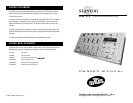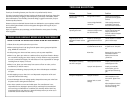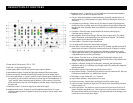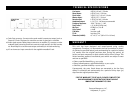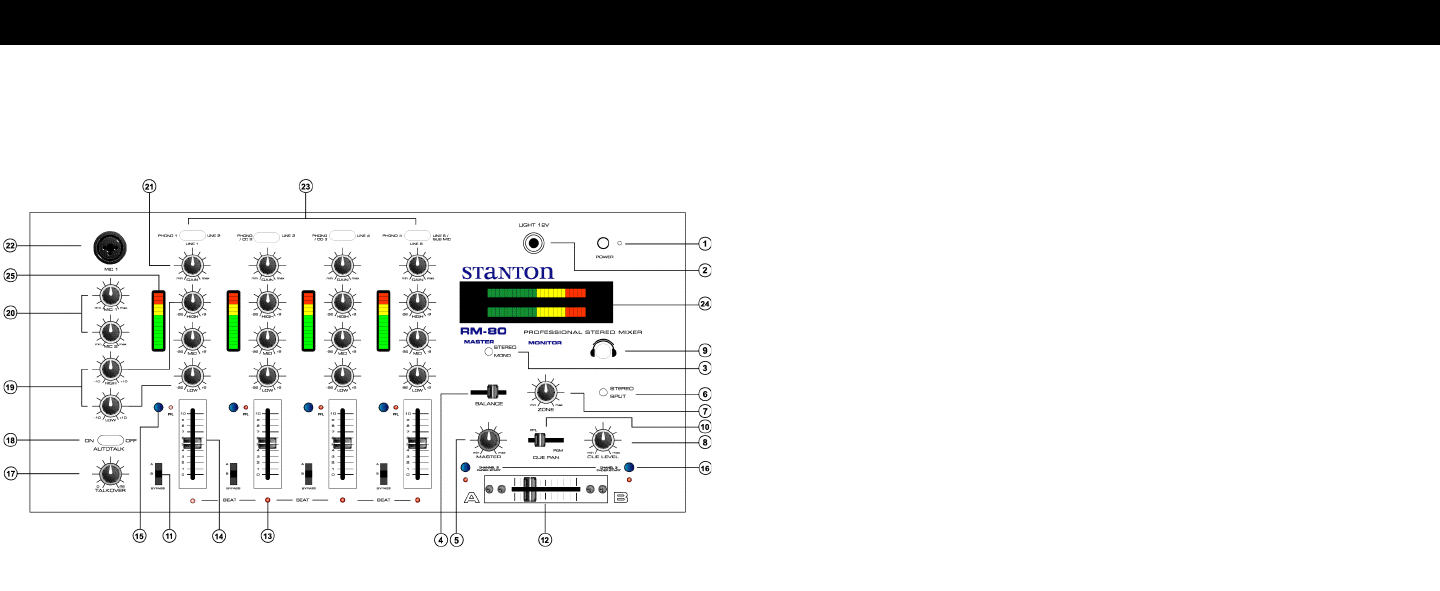
D E S C R I P T ION OF FU N C TI O N S
9. Headphone output: Connection for 1/4 inch headphone. Recommended headphone
impedance is 32-200 ohms for maximum volume.
10. Cue pan: Fades the headphone output between the channel(s) selected by the cue
assign switches (15) and the master one output, effectively allowing the user to pre-
view a mix.
11. Crossfader source selectors: When set to A, the selecte channel will be assigned to
the left side of the crossfader. when set to B, the selected channel will be assigned to
the right side of the crossfader. When set to BYPASS, the crossfder will be bypassed
alltoghter.
12. Crossfader: Fades the master output between the channels selected by the
Crossfader source selectors (13).
13. Beat indicators: Illuminate according to the beat of the program music. The replace-
ment of illumination varies depending on the style of music selected. This features
offers a helpful visual indicator of beat alignment.
14. Channel fader: Controls the input channel level.
15. Cue assign switch: Selects the channel to be monitored.
16. Fader Start: Turns the fader start function ON or OFF.The fader start will work with CD
players (such as Stanton’s S-Series) to start the audio from teh CD player’s cue point.
17. Talkover attenuation control: Sets the amount of attenuation applied to the music
output signal when switch (20) is applied and the mic is spoken into. The attenuation
is adjustable from zero to twenty six decibels.
18. Mic selector: Turns the mic on or off and activates the automatic talkover circuit.
When activated, the automatic talkover circuit reduces the music output based on the
setting of the talkover attenuation control (19).
19. Equalizer: Individual controls for low frequency, midrange, and high frequency
equalization with (+10/-10 dB) Note: Any changes made to EQ settings will change the
overall output level.
20. Microphone volume: Controls the output levels of mics 1 and 2
21. Input channel controls: Controls the input sensitivity of each channel and Hi, Mid, and
Low frequency equalization (+9/-26dB) of each channel.
22. Microphone 1 input: Combo XLR / 1/4” connector
23. Input selector switches: Selects phono or line input.
24. Output Level meter: Displays the overall signal level of the master output.
25. Input Level meter: Displays the input level. The input level is determined by the input
channel controls (21).
26. Audio signal inputs: Line inputs are used to connect to line level sources such as CD
players, samplers, tape players, etc. Phono inputs are used to connect to turntables.
Mic inputs connect directly to microphones. To prevent potential circuit damage, never
connect line level source to phono inputs.
1. Power switch: Selects power "ON" or "OFF".
2. BNC jack: 12V gooseneck light input
3. Mono/stereo switch: Controls mono/stereo signal output of Master 1
4. Master balance control: Controls left/right signal balance of the master output.
5. Master level control: Controls the overall signal output level of the master output.
6. Cue stereo/split switch: In "stereo" position, the pre-selected signal of switches (15)
and controls (9) and (10) will be monitored as a stereo signal in the headphones. In
"split" position, the pre-selected signal of switches (13) and controls (23) and (24)
will be monitored on one side of the headphones, and the master 1 output signal on
the other side.
7. Booth level control: Controls the signal level of the booth output.
8. Headphone level control: Controls the overall headphone output level. It is recom-
mended headphones with an impedance rating of 200 ohms or less be used for maxi-
mum volume.



